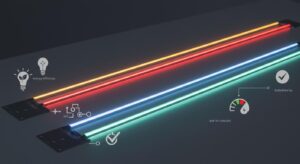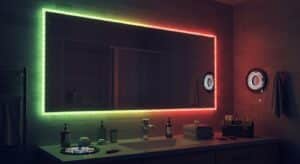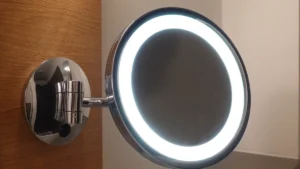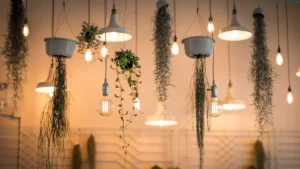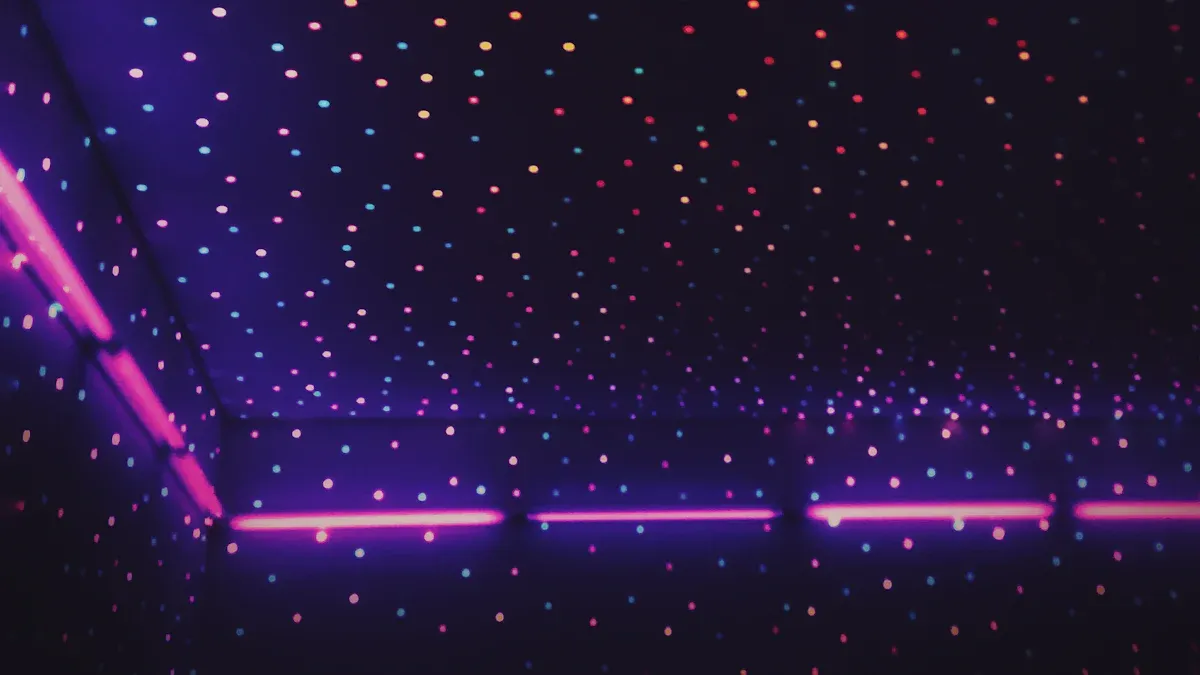
Changing your room’s vibe is now super simple. USB LED light strips are a stylish way to personalise your space. These flexible lights use up to 85% less power than old-style bulbs, so they are better for the planet. They are also much cheaper now, as prices have dropped a lot. You can enjoy bright, customisable lights without spending too much money.
Key Takeaways
USB LED light strips save energy, using 85% less power than regular bulbs. They are a budget-friendly option for lighting your room.
Pick the right LED strip by checking brightness, colours, and if it works with your devices. This helps set the mood you want.
Install and care for LED strips properly. Clean them and use surge protectors to make them last longer and work well.
Choosing the Right LED Light Strip
Brightness and Colour Options
When picking an LED light strip, think about brightness and colours. Brightness is measured in lumens; more lumens mean brighter light. For a warm, cosy feel, choose lower lumens. For work lighting, go for higher lumens.
LED strips come in many colours, from single-colour to multi-colour. Some let you switch between warm and cool white tones. Others offer a full range of colours. Check if the strip can dim to change how bright it is.
Tip: Planning to use the strip outside or in damp places? Look for weatherproofing features like IP ratings. IP65-rated strips handle splashes, while IP68-rated ones can go underwater.
Compatibility with Devices
Make sure the LED strip works with your devices. USB-powered strips connect easily to laptops, TVs, or power banks. Always check the strip’s voltage matches your device to avoid problems.
Some strips work with smart home systems, so you can use voice control with Alexa or Google Assistant. If you prefer simple controls, pick one with a remote.
Note: Long strips might lose brightness at the far end due to voltage drop. Check the strip’s details to ensure it fits your needs.
Features to Look For
New LED strips have cool features that make them easier to use. Here are some important ones:
Remote Control: Change brightness and colours without getting up.
App Integration: Use your phone to customise and schedule lights.
Colour Rendering Index (CRI): High CRI makes colours look more real.
Weatherproofing: Needed for outdoor or damp areas.
Feature | Benefit | Example Use Case |
|---|---|---|
Remote Control | Adjust settings easily | Changing TV backlight colours |
App Integration | Personalise and plan lighting | Setting mood lighting schedules |
High CRI | Makes colours look natural | Lighting for artwork displays |
Weatherproofing | Lasts longer in tough conditions | Outdoor patio lighting |
Compare these features to find the best strip for your space. It will help you create the perfect atmosphere.
Installing Your LED Light Strip
Getting the Surface Ready
Before putting up your LED light strip, clean the surface well. A clean surface helps the strip stick properly and stay in place longer.
First, decide where you want the strip to go. Measure the area to make sure it fits. Wipe the surface with a damp cloth or alcohol wipes to remove dirt, grease, or dust. Let it dry completely before starting.
Tip: Don’t stick the strip on bumpy or rough surfaces. It won’t stick well and might look uneven.
Easy Installation Steps
Follow these simple steps to install your LED light strip:
Plan and Measure: Decide where to place the strip. Measure the space to ensure the strip is the right length.
Clean the Surface: Wipe the area clean to remove anything that might stop the strip from sticking.
Attach the Strip: Peel off the sticky backing and press the strip onto the surface. Do this slowly to avoid air bubbles.
Cut Extra Length: If the strip is too long, cut it at the marked spots. Only cut where it’s safe to avoid damage.
Plug It In: Connect the strip to a USB port or power bank. Make sure the voltage matches the strip’s needs.
Test and Adjust: Turn it on to check if it works. Change the brightness and colours to your liking.
Note: If your strip has controllers or dimmers, connect them during setup to adjust the lights easily.
Keeping the Strip Secure
To make your LED light strip last longer, attach it properly.
Use aluminium channels to protect the strip and help with heat. These channels also make it look neat.
Indoors, smooth metal surfaces work best for sticking the strip. Clean the surface first for better results.
Outdoors or in wet areas, use mounting brackets. They keep the strip secure even in bad weather.
Tip: Don’t move the strip around too much. This can weaken the sticky backing and make it fall off.
Creative Uses for LED Light Strips
Enhancing Furniture and Shelves
LED light strips can make furniture look amazing. Put them inside bookshelves or wardrobes for a soft glow. This highlights your items nicely. Warm white lights under beds or headboards create a cosy bedroom vibe. RGB strips under sofas or behind cabinets add fun lighting. They are great for movie nights or hosting friends.
Tip: Use dimmable LED strips to change brightness for different moods.
Backlighting TVs and Monitors
Adding LED strips behind your TV or monitor improves viewing. The light reduces eye strain and gives a cinema-like feel. RGB strips can match the colours of what you’re watching. This works well for action films or calm nature shows.
Gamers can sync lights with their games for more excitement. App-controlled strips let you change colours and brightness easily.
Note: Make sure the strip is long enough to cover all screen edges.
Adding Ambience to Beds and Desks
LED strips can make beds and desks look cool and useful. Voice-controlled strips let you change lights without touching anything. Warm tones help you relax, while cool tones are good for work. Music-syncing strips add fun, especially during creative tasks or relaxing.
Tip: Place the strip under your desk or bed for a neat glow that saves space.
Maintaining and Troubleshooting LED Light Strips
Cleaning and Care Tips
Taking care of your LED light strips helps them last longer. Follow these simple tips to keep them working well:
Wipe the strips often to stop dust and dirt from building up. This keeps them bright and prevents overheating.
Use a dimmer to run the lights at 70-80% brightness. This avoids overheating and saves energy.
Place the strips in areas with good airflow to stop heat damage.
Protect the strips from power surges by using surge protectors or voltage regulators.
When cleaning, follow these steps:
Gently dust the strips with a soft, dry cloth.
For tough stains, use a damp cloth with mild soap or alcohol.
Always unplug the strip before cleaning to stay safe.
Dry the strip fully with a lint-free cloth before plugging it back in.
Tip: Don’t use rough materials that could scratch or harm the strip.
Fixing Common Issues
Sometimes, LED light strips may stop working properly. Here are common problems and how to fix them:
Problem | Causes | Fixes |
|---|---|---|
Flickering | Loose wires, weak power, or overloaded circuits | Tighten wires, use a 12V power source, check the driver, or replace it if needed |
Dead Sections | Broken strips, bad soldering, or faulty product | Look for damage, check connectors, or contact the maker for a replacement |
Colour Problems | Wrong wiring or poor manufacturing | Fix the wiring, reset the remote, or buy better-quality strips |
Dimming Issues | Wrong dimmer or not enough power | Use a compatible dimmer, upgrade the power source, or connect strips in parallel for longer setups |
Note: If the problem doesn’t go away, ask an expert for help with tricky setups.
Knowing When to Replace or Upgrade
Even though LED light strips last a long time, they don’t work forever. Replace or upgrade them if you notice these signs:
The strip is much dimmer or has uneven brightness.
It flickers or has dead spots that can’t be fixed.
It lacks modern features like app control or voice commands.
Newer strips are more energy-efficient and have better features. They also give brighter and higher-quality light.
Tip: Upgrade your strip if it no longer suits your needs or matches your room’s look.
USB LED light strips are an easy way to change your room. Pick a strip that fits your needs and style. They are simple to set up and can be used in fun ways. These lights let you decorate your space without spending too much. Try them now to make your room warm and welcoming.
FAQ
How do I choose the right length for my LED light strip?
Measure the area where you plan to install the strip. Ensure the length matches your space to avoid cutting or wasting material.
Can I use LED light strips outdoors?
Yes, but choose weatherproof strips with an IP65 or IP68 rating. These resist water and dust, making them ideal for patios or gardens.
What should I do if my LED light strip stops working?
Check the connections and power source. Inspect for damage or loose wires. Replace faulty parts or contact the manufacturer for support.
See Also
Effective Methods for Installing RGB LED Strip Lights
Best Practices for Installing LED Strip Lights in 2025
Innovative Ways to Utilise LED Light Strips on Ceilings
Customisation Options for COB LED Strip Lights
Unique LED Strip Lighting Concepts for the Christmas Season
